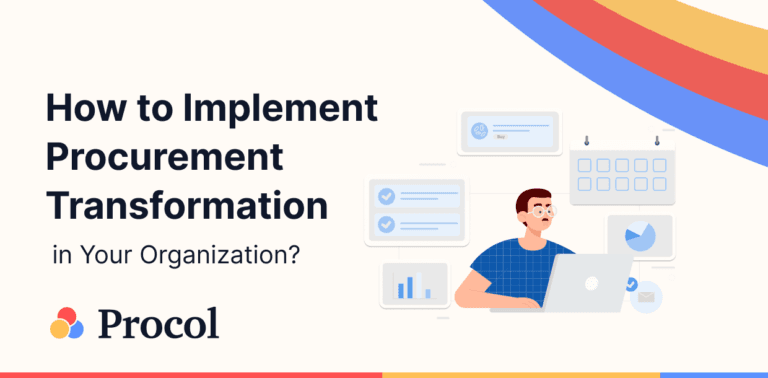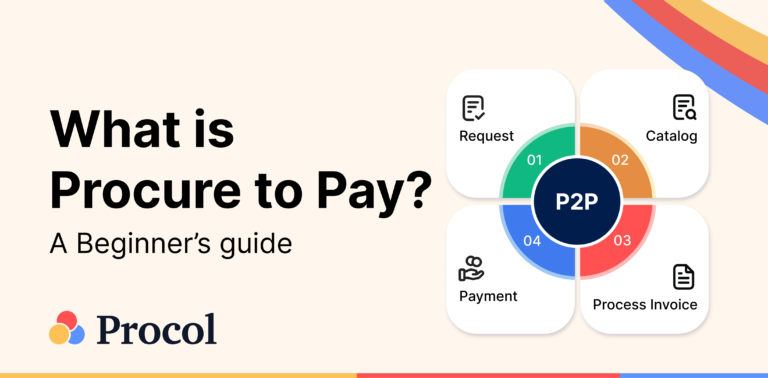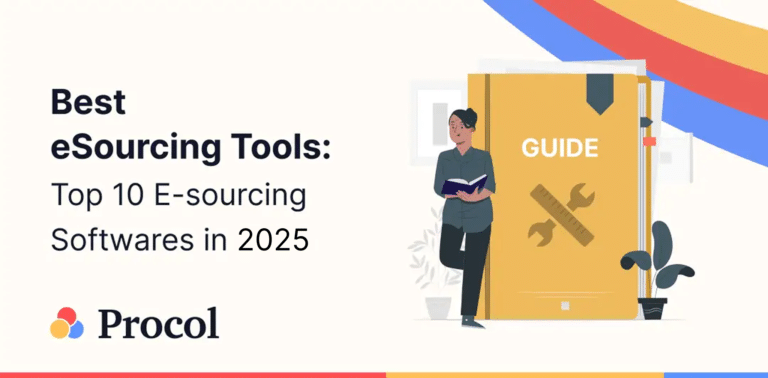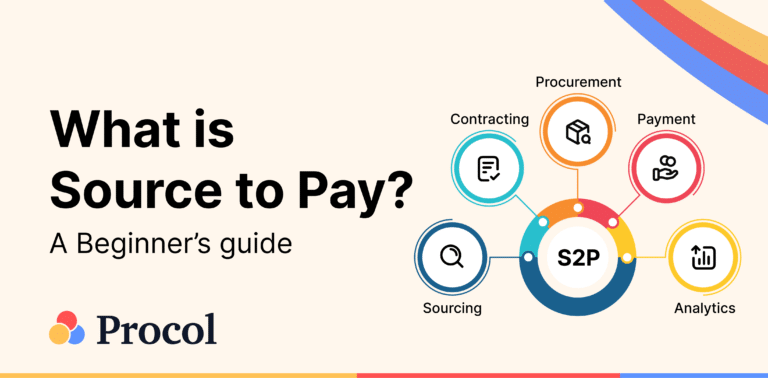Procol • April 15, 2025
How to Implement Procurement Transformation in Your Organization?

In today’s ever-changing business world, procurement transformation is important if companies want to keep their edge and boost productivity. This complete overhaul of how they buy goods and services changes the game in supply chain management, cost control, and value creation. Companies must adapt their purchasing strategies to handle new problems and opportunities as global markets get trickier.
Procurement transformation involves many steps, from adopting the latest technology to restructuring organizations and developing new expertise. The full article explains how procurement is changing worldwide.
What is Procurement Transformation?
Procurement transformation is not just a change in processes, it’s a strategic shift. It’s about how a company’s procurement functions move from a tactical focus to a more significant role in the business. This change matters because it empowers procurement teams with more important jobs. These teams are now integral to adding value, achieving sustainable results, and helping companies stay ahead of the competition even when markets change or supply chains have problems.
At its core, procurement transformation means changing how a company buys goods and services. This process involves a bunch of different activities, such as:
- Making purchasing processes work better
- Cutting down on costs
- Increasing transparency
- Getting better quality goods and services
Key Aspects of Procurement Transformation
To implement global procurement transformation, companies need to assess how they buy things now and identify areas for improvement. This means digging deep into all their buying activities to map out a plan for bringing their procurement into the digital age. After they figure out what’s not working or where they can step things up, companies can start implementing changes in how they handle their buying processes.
- Improving Efficiency and Effectiveness: To change how procurement works, companies need to simplify and automate tasks in their business units. Using AI to automate buying can save time and money.
- Embracing Technology: Digital tools are not just tools but the future of procurement. They are vital to automating tasks, analyzing data, and helping company employees work together. This includes using AI, cloud-based solutions, and e-procurement systems, all of which pave the way for a more efficient and effective procurement process.
- Focusing on Sustainability and Ethics: Companies need to use responsible sourcing methods to improve ethical and environmental standards in their supply chain management.
What Procurement Transformation Has Importance in Business?
Companies recognize the growing importance of transforming their procurement functions to keep up with new business needs and stay ahead in today’s ever-changing market. Overhauling purchasing practices has an impact on businesses for several key reasons:
- Shifting Role of Procurement: Procurement is changing from a tactical cost center to a strategic function that adds value. Companies now want their procurement teams to bring value across the organization, not just source suppliers. This change means teams must rework their traditional ways to match the company’s wants.
- Growing Complexity: Procurement teams now deal with more challenging problems and have more responsibilities. They must handle different things like category strategy, managing suppliers and risks, diversity, and sustainability. This means they need new ways of working and new skills.
- High Efficiency and Productivity: Companies must improve their procurement without hiring more people. This is tricky and requires new ideas to handle more significant, complicated spending categories.
- Technological Advancements: Digital tools and technologies are changing procurement. Top companies now use better source-to-pay (S2P) technology to boost output and simplify their operations.
- Remote Work Adaptation: New manual methods are becoming obsolete as teams switch to working from home. Going digital lets far-flung teams work together seamlessly.
- Process Optimization: Many companies deal with tricky purchasing systems, slow invoice reconciliation, and unreliable delivery. These problems show why making buying and procure-to-pay processes digital and automatic is essential.
- Resource Allocation: IT and developer shortages often slow procurement processes. Automating repetitive tasks can ease the load on IT resources, allowing them to tackle more critical problems.
- Risk Management: The sourcing team faces many risks because of separate processes and poor communication between suppliers and in-house teams. Change is needed to lower these risks and strengthen the supply chain.
What is Included in Procurement Transformation?
Procurement transformation is changing how a company buys goods and services. This includes procurement transformation steps and plans to make buying better. Several vital parts work together to boost productivity, cut expenses, and clarify things. Here are the main components of digital transformation in procurement:
Digital Procurement Elements:
The first move in changing procurement is to swap old systems for digital ones. This has an impact on:
- Getting rid of paper and manual tasks
- Setting up electronic systems to keep an eye on buying activities
- Making the buying process more open and responsible
New Sourcing Plans:
Changing procurement often involves changing how companies find suppliers, which helps them:
- Find new suppliers
- Get better prices for goods and services
- Use total cost of ownership (TCO) analysis to spot actual costs and study suppliers
Putting New Processes and Procedures into Action:
To revive old-fashioned procurement tasks, companies set up:
- Automatic procurement workflows to boost operations
- New steps to okay and follow purchases
- Ways to ensure quick approvals and payments
Learning and Growth:
People are the key to good procurement. To make procurement changes work, you need:
- Full support from staff
- A clear grasp of new tech and methods
- Good training for staff to do their jobs well
- Chances to keep learning as things change
Electronic Procurement Systems:
Companies often bring in new tech to change how they work, like:
- Online buying platforms
- Systems that buy stuff on their own
- Digital tools to manage suppliers and keep an eye on contracts.
How Does Procurement Transformation Benefit Organizations?
Digital transformation of procurement enhances organizational efficiency, cost-effectiveness, and strategic positioning through digital technologies and modernized processes.
1. Cost Reduction and Efficiency Improvements: Digital transformation in procurement streamlines workflows, reducing expenses and saving time. Automating repetitive tasks improves the efficiency of purchasing, PO, and invoice approvals.
2. Enhanced Productivity and Team Motivation: Staff focus on high-value, strategic tasks, boosting productivity and morale. Employees engage in meaningful work and feel more valued.
3. Improved Quality and Transparency: Digital technologies enhance transparency, ensuring better value and reducing fraud risks.
4. Strategic Value Creation and Innovation: Procurement digital transformation becomes a strategic partner, optimizing costs and fostering innovation through supplier collaboration.
5. Enhanced Supplier Relationships and Market Insights: Digital platforms streamline supplier interactions and provide market trend insights.
6. Increased Business Agility and Resilience: Data analytics improve forecasting and responsiveness to market changes and supply chain disruptions.
7. Sustainability and Ethical Practices: Advanced analytics enable environmental impact measurement, ensuring supply chain sustainability and regulatory compliance.
Best Practice that a Business must Implement for a Successful Procurement Transformation Roadmap
Putting a procurement transformation roadmap into action needs a strategic technique to boost buying tasks and align them with company goals. This process impacts the procurement department from a tactical cost-saving unit to a strategic value-boosting part of the business. To put a procurement transformation roadmap into action, companies should follow these top tips:
- Evaluate Current Processes: Companies need to examine procurement workflows and practices. This means examining procurement activities and finding where things slow down or waste time. It’s critical to examine their tech stack, see if there are gaps or if they have too many tools doing the same thing, and figure out where information is stuck in one place.
- Find Ways to Get Better: Based on the assessment, organizations should pinpoint specific aspects of procurement operations that can be optimized, streamlined, or automated to enhance efficiency and effectiveness. This step helps them find ways to spend less money, work smarter, and get better stuff and services.
- Create a Transformation Roadmap: Design a plan to outline goals, targets, schedules, and assets for procurement digital transformation projects. The roadmap should include clear aims for transformation, resources, and schedules. The specific phases may differ based on the company’s requirements and targets.
- Get Executive Support: Explain the advantages and critical importance of digital transformation of procurement to gain backing and dedication from top leaders. This involves figuring out the suggested investment’s return on investment as an Internal Rate of Return (IRR) and Net Present Value (NPV).
- Pick and Put in Place the Right Technologies: Find and deploy good tech tools, like buying software and data tools, to improve your buying and get the desired results. Technologies should play a significant role in changing how you buy, but it’s critical to focus on tools that will make the most significant difference and are doable.
- Address Changes: Get ahead of people who do not want change, give training and help, and build a workplace that likes new ideas and is always getting better at using new ways of working and new tech. This means creating a workplace that’s okay with changing new tech and brave enough to reach significant goals.
- Continuous Improvement and Measurement: Set up metrics, key performance indicators (KPIs), and benchmarks to monitor progress, check performance, and spot opportunities to improve procurement. This step involves tracking progress, analyzing results, and tweaking the approach.
7 Steps to Creating a Procurement Transformation Strategy
Organizations can go with procurement digital transformation by following these procurement transformation strategy key steps:
- Assessment and Visioning: Evaluate current processes, identify improvements, and outline future state.
- Strategy and Planning: Develop a roadmap aligned with organizational goals.
- Building the Foundation: Establish governance, assemble a skilled team, and implement essential digital tools.
- Technology Implementation: Deploy solutions to streamline processes and gain data-driven insights.
- Supplier Collaboration: Build strong relationships with suppliers to ensure quality and reduce risks.
- Continuous Improvement: Set metrics and KPIs to monitor progress and optimize performance.
- Cultural Change: Foster a culture embracing change and innovation for long-term success.
How can AI help in Procurement Transformation?
AI transforms procurement by offering profound insights, automating tasks, and enabling data-driven decisions. It learns and adapts by processing vast data volumes. In today’s uncertain environment, AI’s rapid data analysis helps companies stay agile. Businesses use AI to gain a competitive edge, streamline processes, and equip decision-makers with powerful tools.
AI has an impact on various aspects of procurement transformation:
Improved Decision-Making:
AI provides timely analytics and data-driven insights for better sourcing decisions. It can analyze vast amounts of data from multiple sources across the source-to-pay process, including historical prices, supplier credentials, contracts, supply market news, quality trends, and operational data flows.
Automation of Manual Tasks:
AI can automate time-consuming tasks like monthly processes or procurement performance reporting. This automation can reduce processing costs by as much as 40% and save time on some procurement processes by up to 60%.
Enhanced Spend Analysis:
AI algorithms can perform spend classification with high accuracy.
Optimized Supplier Relationships:
AI can make supplier relationship management more data-informed. It can automatically identify non-compliance with suppliers and alert users to any discrepancies with contracts or invoices.
Predictive Analytics:
AI impacts data-driven forecasting, risk insights, and optimizations. It can analyze vast amounts of structured and unstructured data to spot trends and patterns and make predictions to suggest actions.
Natural Language Processing (NLP):
Computer systems can grasp, interpret, and create human languages. It’s used in procurement chatbots to find suppliers based on capability descriptions and extract insights from documents.
Risk Management:
AI algorithms can recognize high-level sourcing strategies by determining their value and recognizing shifts in global supply trends. This allows procurement teams to assess options with additional insight, helping them anticipate changes and stay ahead of competitors.
How Does Procol Transform Your Procurement?
Procol, one of India’s leading procurement software solutions, has revolutionized how companies manage their procurement operations. By digitizing and automating the entire source-to-contract journey, Procol eliminates the need for manual labor and transforms procurement processes for top companies.
Procol’s comprehensive solution offers several key features that contribute to effective digital transformation in procurement:
1. Automation and Efficiency:
Procol’s software automates essential operations, streamlining the entire procurement process. This automation leads to increased efficiency and significant time savings, with some procurement processes seeing up to 60% reduction in processing time.
2. Cost Savings:
By implementing Procol’s “Agile” approach, companies can achieve substantial cost savings with minimal human intervention. Procol customers have generated over $100 million in savings, demonstrating the software’s potential to impact the bottom line positively.
3. Mobile-First Approach:
Procol empowers procurement teams with a dedicated mobile-first platform, ensuring professionals have the flexibility to drive efficiency wherever they are. This feature is precious in today’s dynamic work environment.
4. Customizable Workflows:
Businesses gain the flexibility of customizable workflows and templates that meet their precise organizational needs. This adaptability ensures that Procol can be tailored to fit various procurement scenarios across different industries.
5. Extensive Supplier Network:
Procol provides access to over 50,000 suppliers registered and onboarded globally. This vast network expands sourcing options and enhances supply chain resilience.
6. User-Friendly Interface:
With its intuitive interface and unmatched efficiency, Procol ensures quick setup and easy adoption across the organization. This user-friendly approach minimizes training time and accelerates the transformation process.
7. Spend Analytics:
Procol’s spend analytics dashboard helps businesses create data boards, analyze expenditures, and identify bottlenecks. This feature reduces costs and improves compliance, providing valuable insights for strategic decision-making.
8. Process-Data Mining:
Recent innovations in process-data mining enable businesses to streamline approval processes, identify and resolve inefficiencies, and harmonize processes across business units and geographical regions. This technology empowers companies to define end-to-end value streams and buying channels, enhancing efficiency and cost reduction.
9 Digital Transformation Trends that Affect Procurement
The digital revolution is changing how companies handle their buying and sourcing. As tech keeps growing, several significant shifts are reshaping procurement. Here are nine procurement digital transformation trends making waves in procurement today:
AI and Automation:
Smart technologies and robots are changing how procurement works. They do boring jobs like data entry and bill processing, letting procurement staff focus on big-picture tasks. AI helps pick better suppliers, manage risks, and forecasting.
Blockchain for Clear Supply Chains:
Blockchain makes tracking where things come from more straightforward. It reduces cheating, ensures ethical buying, and helps suppliers work better by keeping clear, unchangeable records.
Supplier Relationship Management (SRM):
Digital tools help procurement teams work well with suppliers, share their progress, and find ways to improve. This leads to stronger partnerships, better deals, lower costs, and more new ideas.
E-Procurement and E-Sourcing:
These digital answers speed up requisition, bidding, and managing orders. Moving away from paper speeds up the whole process, helps you follow the rules, and makes data more accurate.
Mobile Procurement:
With mobile tech, procurement professionals can work independently. Apps let them check and approve orders, track shipments, and monitor supplier performance, making work quicker and more responsive.
Data-Driven Choices:
Data analysis helps spot patterns and opportunities, leading to smarter procurement choices. It also helps predict what’s needed and manage risks better.
Integrated Ecosystems:
There’s a move towards using modern procurement technology as part of more extensive, connected systems. This approach ties supply chains into larger platforms instead of treating them separately.
Increased Investment:
Worldwide spending on digital changes is set to hit $6.8 trillion in 2023. This growth comes from businesses using tech to handle more considerable money risks and improve their work.
Better Tracking and Analysis:
Advanced technologies offer a high degree of granularity, enabling better metrics for procurement ROI, contract compliance, contract life savings, process efficiency, and invoice accuracy. This helps improve procurement processes.
Conclusion
Procurement transformation reshapes supply chain management and value creation. This strategic, digital approach boosts efficiency and cuts costs. AI and automation streamline processes and improve supplier relationships.
The transformation journey is ongoing and needs a solid strategy. Companies investing in change are better prepared for future challenges. As business evolves, procurement transformation will be crucial for global competitiveness.
Explore more from Procol
Discover expert tips, how-to guides, industry insights, and the latest procurement trends.

What is Procure-to-pay (P2P)? An Ultimate Guide
Procure to pay is the process from procurement of materials needed...

Best eSourcing Tools: Top 10 eSourcing Software in 2025
Discover top 10 e-sourcing tools and esourcing platforms necessary for efficient...

What is Source-to-pay in 2025? An Ultimate Guide
Source to pay is the process of sourcing vendors to procure...



















